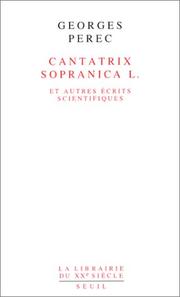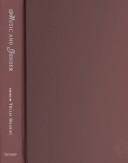| Listing 1 - 10 of 59 | << page >> |
Sort by
|

ISBN: 2020136503 9782020136501 Year: 1991 Publisher: Paris Seuil
Abstract | Keywords | Export | Availability | Bookmark
 Loading...
Loading...Choose an application
- Reference Manager
- EndNote
- RefWorks (Direct export to RefWorks)
Multi
ISBN: 9780521817059 9781139024419 9781107630093 9781139220453 1139220454 9781139223881 1139223887 1139024418 0521817056 9781139217361 1139209353 9781139209359 1316088995 9781316088999 1280393734 9781280393730 1139222171 9781139222174 9786613571656 6613571652 1139217364 9781139217361 1139214284 9781139214285 1107630096 Year: 2012 Publisher: Cambridge Cambridge University Press
Abstract | Keywords | Export | Availability | Bookmark
 Loading...
Loading...Choose an application
- Reference Manager
- EndNote
- RefWorks (Direct export to RefWorks)
Why do we sing and what first drove early humans to sing? How might they have sung and how might those styles have survived to the present day? This history addresses these questions and many more, examining singing as a historical and cross-cultural phenomenon. It explores the evolution of singing in a global context - from Neanderthal Man to Auto-tune via the infinite varieties of world music from Orient to Occident, classical music from medieval music to the avant-garde and popular music from vaudeville to rock and beyond. Considering singing as a universal human activity, the book provides an in-depth perspective on singing from many cultures and periods: Western and non-Western, prehistoric to present. Written in a lively and entertaining style, the history contains a comprehensive reference section for those who wish to explore the topic further and will appeal to an international readership of singers, students and scholars.
Music --- Singing --- Chant --- History. --- Histoire --- Vocal music --- History and criticism.
Book
ISBN: 0198163479 Year: 1993 Publisher: Oxford Clarendon
Abstract | Keywords | Export | Availability | Bookmark
 Loading...
Loading...Choose an application
- Reference Manager
- EndNote
- RefWorks (Direct export to RefWorks)
Labour market --- Service industry --- Great Britain --- Singers --- Economic conditions --- Singing
Book
ISBN: 9789042917958 9042917954 Year: 2007 Volume: 14 Publisher: Leuven Peeters
Abstract | Keywords | Export | Availability | Bookmark
 Loading...
Loading...Choose an application
- Reference Manager
- EndNote
- RefWorks (Direct export to RefWorks)
Dit boek bestudeert het werk van de dertiende-eeuwse mystica Hadewijch op het kruispunt van oraliteit, verschriftelijking, memoria en meditatie. Vertrouwd als ze is met de nog bestaande orale zang- en vertelcultuur in het Hongaars sprekende deel van Roemenië en met de middeleeuwse muziek, kan Anikó Daróczi aannemelijk maken dat Hadewijch haar mystieke ervaringen uitdrukte met behulp van in het geheugen en zintuigen ingeprente verbale formules en melodiebewegingen, en dan niet alleen in haar poëzie, maar ook in haar proza. Het gaat hier om een zingend spreken vanuit een levende traditie, die niet alleen het hoofd, maar het hele lichaam van de auteur beheerst. Dit zingend spreken wil de hele persoonlijkheid van de lezer (die in de middeleeuwse leescultuur ook altijd een toehoorder is) raken, zodat deze zich de tekst in lectio en meditatio kan toe-eigenen. Eén keer dat dit inzicht gerijpt is, worden vele kenmerken van Hadewijchs taal duidelijk: het registrale karakter van Hadewijchs poëzie; de vele 'citaten' in haar teksten uit de Bijbel en uit de Latijnse en volkstalige literatuur; de inbreuken tegen de syntaxis die de filologen op de proef stellen; en vooral het zeer bijzondere ritme van haar proza, dat in één berucht geval (Brief 28) zo overheersend en allesbepalend wordt, dat verschillende Hadewijchspecialisten deze tekst - in weerwil van de handschriftellijke overlevering - aan de Brabantse mystica menen te moeten ontzeggen. Dit boek overstijgt het belang van de Hadewijchstudie omdat het kritische vragen stelt over de pertinentie van de in de medioneerlandistiek vigerende filologische methode.
Hadewijch --- Oral communication in literature. --- Singing in literature. --- Hadewijch, --- Criticism and interpretation. --- Technique --- Oral communication in literature --- Singing in literature --- Hadewich, --- Hadewych, --- Hadewych
Book

Year: 2008 Publisher: Tielt Lannoo
Abstract | Keywords | Export | Availability | Bookmark
 Loading...
Loading...Choose an application
- Reference Manager
- EndNote
- RefWorks (Direct export to RefWorks)
Sociology of culture --- Music --- choirs [church spaces] --- singing [perfoming arts genre]
Multi
ISBN: 9781108768887 9781108488075 9781108738415 1108488072 1108768881 1108775950 1108781829 Year: 2020 Publisher: Cambridge Cambridge University Press
Abstract | Keywords | Export | Availability | Bookmark
 Loading...
Loading...Choose an application
- Reference Manager
- EndNote
- RefWorks (Direct export to RefWorks)
A primary mode for the creation and dissemination of poetry in Renaissance Italy was the oral practice of singing and improvising verse to the accompaniment of a stringed instrument. Singing to the Lyre is the first comprehensive study of this ubiquitous practice, which was cultivated by performers ranging from popes, princes, and many artists, to professionals of both mercantile and humanist background. Common to all was a strong degree of mixed orality based on a synergy between writing and the oral operations of memory, improvisation, and performance. As a cultural practice deeply rooted in language and supported by ancient precedent, cantare ad lyram (singing to the lyre) is also a reflection of Renaissance cultural priorities, including the status of vernacular poetry, the study and practice of rhetoric, the oral foundations of humanist education, and the performative culture of the courts reflected in theatrical presentations and Castiglione's Il cortegiano.
History of Italy --- poetry --- singing --- anno 500-1499 --- Poetry --- Italian literature --- Vocal music --- Italian poetry --- Folk poetry, Italian --- Humanism --- History and criticism. --- Italy --- Civilization --- singing [perfoming arts genre] --- Electronic books
Book
Year: 1992 Publisher: Louvain-la-Neuve Centre d'histoire de l'Afrique
Abstract | Keywords | Export | Availability | Bookmark
 Loading...
Loading...Choose an application
- Reference Manager
- EndNote
- RefWorks (Direct export to RefWorks)
Book
ISBN: 2010124197 9782010124198 Year: 1994 Publisher: Paris Hachette
Abstract | Keywords | Export | Availability | Bookmark
 Loading...
Loading...Choose an application
- Reference Manager
- EndNote
- RefWorks (Direct export to RefWorks)
French literature --- Marais, Marin, --- Human sounds --- Throat --- Diaphragm --- Larynx --- Singing and voice culture --- Vocal culture --- Beatboxing --- Throat singing --- Marais, Marin --- -Speaking --- Composers --- Music --- Compositeurs --- Musique --- Biography --- Miscellanea --- Biographies --- Miscellanées --- Singing --- Voice --- Speaking --- Language and languages --- Elocution --- Phonetics --- Speech --- Physiological aspects --- Performance --- Marin-Marais, --- Marais, M. --- Marais, Marin, - 1656-1728 --- Esthétique --- Philosophie
Book
ISBN: 019884378X 9780198843788 0191879487 0192581937 0192581945 0192865528 9780192865526 Year: 2019 Publisher: Oxford Oxford University Press
Abstract | Keywords | Export | Availability | Bookmark
 Loading...
Loading...Choose an application
- Reference Manager
- EndNote
- RefWorks (Direct export to RefWorks)
Given the variety and richness of the sixteenth- and seventeenth-century English 'songscape', it might seem unsurprising to suggest that early modern song needs to be considered as sung. When a reader encounters a song in a sonnet sequence, a romance, and even a masque or a play, however, the tendency is to engage with it as poem rather than as musical performance. Opening up the notion of song from a performance-based perspective The Matter of Song in Early Modern England considers the implications of reading song not simply as lyric text but as an embodied and gendered musical practice. Animating the traces of song preserved in physiological and philosophical commentaries, singing handbooks, poetic treatises, and literary texts ranging from Mary Sidney Herbert's Psalmes to John Milton's Comus, the book confronts song's ephemerality, its lexical and sonic capriciousness, and its airy substance. These features can resist critical analysis but were vital to song's affective workings in the early modern period. The volume foregrounds the need to attend much more closely to the embodied and musical dimensions of literary production and circulation in sixteenth- and seventeenth-century England. It also makes an important and timely contribution to our understanding of women's engagement with song as writers and as performers. A companion recording of fourteen songs featuring Larson (soprano) and Lucas Harris (lute) brings the project's innovative methodology and central case studies to life.
Ballads, English --- Intellectual life. --- Songs. --- History and criticism --- 1500-1699. --- England --- England. --- Intellectual life --- Songs and music --- History and criticism. --- English literature --- anno 1500-1599 --- anno 1600-1699 --- Poetry --- Songs --- Singing --- History --- Singing and voice culture --- Vocal culture --- Music --- Beatboxing --- Throat singing --- Arias --- Ariettas --- Art songs --- Lieder --- Solo songs --- Solo vocal music, Secular --- Songs with various acc. --- Lyric poetry --- Vocal music --- Recorded accompaniments (Voice) --- Performance

ISBN: 0226501655 0226501663 Year: 2003 Publisher: Chicago, Ill. University of Chicago Press
Abstract | Keywords | Export | Availability | Bookmark
 Loading...
Loading...Choose an application
- Reference Manager
- EndNote
- RefWorks (Direct export to RefWorks)
Music --- Ethnology. Cultural anthropology --- Sociology of culture --- Mediterranean countries --- Ethnomusicology. --- Gender identity in music. --- Women musicians --- History and criticism. --- Race --- Gender --- Musicians --- Religion --- Singing --- Book --- Culture --- Dancing
| Listing 1 - 10 of 59 | << page >> |
Sort by
|

 Search
Search Feedback
Feedback About UniCat
About UniCat  Help
Help News
News